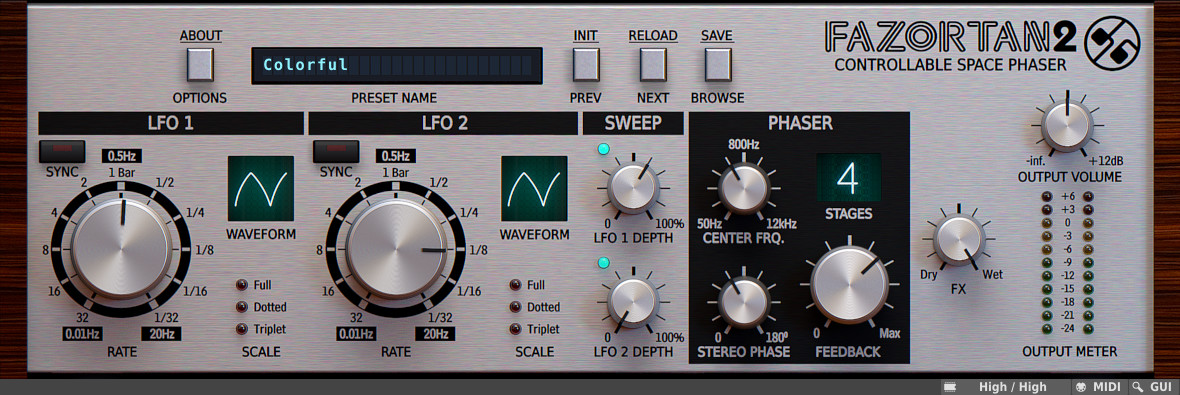MusicRadar Verdict
It might sound essentially the same, but Fazortan 2 is a clear step up over v1.4 when it comes to workflow and UX.
Pros
- +
Sounds superb.
- +
Two LFOs for complex modulation.
- +
Handsome, resizable GUI.
- +
Very fair upgrade fee.
Cons
- -
A 12-stage configuration would be the icing on the cake.
MusicRadar's got your back
Almost exactly a decade ago, we scored D16’s affordable ‘analogue’ phaser plugin, Fazortan, 3.5/5.
We loved the sound, but a few issues stacked up to detract from the overall experience. The GUI was too minimal and esoteric, the LFOs couldn’t sync to the host DAW, and the MIDI learn system was needlessly awkward to get at.
In the years since, D16 has largely addressed our criticisms via version 1 point releases. The GUI has been expanded, the LFOs have been blessed with the full range of note sync options, and the MIDI learn setup has been improved somewhat. All good stuff for owners of Fazortan 1.4, then, turning a fabulous-sounding effect into a far more usable one - but what does Fazortan 2, the first full version update, bring to the party?
Fazor’s edge
At its heart, Fazortan 2 (VST/AU/AAX) is still the same retro-style ‘all-pass’ phase shifter it’s always been. The phase shifter itself can be set to 2, 4, 6 or 8 stages, have its centre frequency positioned anywhere between 50Hz and 12kHz, and feed back into itself via the Feedback knob. Fazortan is a stereo processor, of course, and the Stereo Phase knob increasingly offsets the phase of the left and right signals as it’s raised, for impressive widening of the output signal.
What sets Fazortan apart from other phasers, however, is its two LFOs, the mixed output of which modulates the centre frequency of the phase shifter. Both LFOs draw on the same selection of seven waveforms (Sine, Triangle, Hyper Triangle, Ramp Up, Ramp Down, Square and S+H), and each has its own Rate (0.01-20Hz unsynced, 32/1 to 1/32 with dotted and triplet options synced) and Depth control. By playing around with their timing and relative amounts, an endless range of repeating or constantly shifting (or a combination of the two!) waveforms can be generated, from slow arhythmic sweeps to chaotic, frenzied burbles.
A phaser works by duplicating the input signal and applying a series (2, 4, 6 or 8 in Fazortan 2’s case) of evenly-spaced all-pass filters to one of them. The all-pass filters change the phase of the processed signal, as determined by their frequencies; and when mixed back in with the unprocessed signal, a series of cancellation notches and peaks emerge, creating that characteristic resonance. For emphasis of that resonance, the output can be fed back into the input.
The centre frequency is then modulated by an LFO - or, with Fazortan 2, the mixed output of two LFOs - sweeping the filters up and down cyclically. The waveform of the LFO is what defines the rhythmic style of the modulation - sharp but smooth with the triangle wave, obviously ‘stepped’ with the square wave, random and stepped with S+H, etc - and with Fazortan 2 blending two independent LFOs, there’s no limit to the shapes it can make.
Fazortan 2 doesn’t attempt to mess with this simple and perfectly effective architecture, and although D16 has made improvements to its underlying algorithms, claiming it’s now “closer than ever to the hardware”, the difference isn’t particularly noticeable. That’s fine, though - it’s always sounded wicked.
Instead, v2 brings Fazortan in line with D16’s current standards in terms of workflow and interfacing. The GUI has been rearranged for easier negotiation, and can now be doubled in size for high-res displays; the developers’ proprietary tag-based preset browser is a welcome addition; and MIDI Learn is now - at last - just a right-click away for every control.
Nice ’tan
After ten years of intermittent development, you’d expect any plugin this straightforward to have fully found its feet, and Fazortan 2 does indeed feel like the device it’s always wanted to be. Sonically, it’s one of the best software phasers out there, and the interface flows more effectively than ever. A 12-stage option wouldn’t go amiss, but that’s not the end of the world.
To answer our earlier question, then: not a great deal. But while Fazortan 2 doesn’t introduce much that’s actually ‘new’, it’s certainly enough to warrant the €15 upgrade fee for existing users, and up its appeal to those yet to discover its spacey, swirling charms.
Computer Music magazine is the world’s best selling publication dedicated solely to making great music with your Mac or PC computer. Each issue it brings its lucky readers the best in cutting-edge tutorials, need-to-know, expert software reviews and even all the tools you actually need to make great music today, courtesy of our legendary CM Plugin Suite.
"That's what it takes to make music that's gonna last forever": Olivia Rodrigo and Chappell Roan producer Daniel Nigro on crafting timeless tracks
“A fully playable electro-mechanical synth voice that tracks the pitch of your playing in real time”: Gamechanger Audio unveils the Motor Pedal – a real synth pedal with a “multi-modal gas pedal”
“It was the first rock monster that we'd created”: How an explosive 2001 switch-up revealed just how ferocious Muse could get











